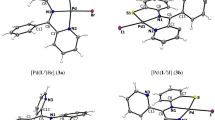Two isopolyoxomolybdate {Mo36} cluster compounds are presented, where one incorporates two sodium ions into the {Mo36} cluster cavity and the other does not, showing different “sensitive coordination sites” to organic cation ligands TEAH+ (protonated triethanolamine) as identified by X-ray crystallography, and rationalized by DFT calculations. The compound (TEAH)6{Na2 [Mo36O112(H2O)14]}· 28H2O (1) crystallizes in the trinclinic space group P−1, a=15.8931(2) Å, b=17.3089(2) Å, c=18.1880(3) Å, \(\alpha=101.210(1)\), \(\beta= 95.481(1)\), \(\gamma=116.585(1)^{\circ}\), V=4292.95(10) Å3, D c=2.688 g cm−3. 16838 unique reflections and 1213 refined parameters were used in structure refinement. R1=0.032, R2=0.071. When sodium is eliminated from the reaction system, the new compound (TEAH)8[Mo36O112 (H2O)14]· 10 H2O (2) was also isolated and crystallographically characterized. Compound 2 crystallizes in the monoclinic space group P−1, a=16.3351(3) Å, b=16.5709(4) Å, c=18.5803(5) Å, \(\alpha=83.330(1)\), \(\beta=65.010(2)\), \(\gamma=85.107(2)^{\circ}\), V=4524.08(18) Å3, D c=2.525 g cm−3. 17591 unique reflections and 1016 refined parameters were used in structure refinement. R1=0.044, R2=0.128.





Similar content being viewed by others
References
L. Cronin (2004), High Nuclearity Polyoxometalate Clusters in Comprehensive Coordination Chemistry 2, Ed. 7, 1; M. T. Pope and A. Müller (1991). Angew. Chem. Int. Ed. Engl. 30, 34; C. L. Hill (1998). Chem. Rev., 98, 1.
Wassermann K., Dickman M. H., Pope M. T. (1997). Angew. Chem. Int. Ed. Engl. 36:1445
Cronin L., Beugholt C., Krickemeyer E., Schmidtmann M., Bögge H., Kögerler P., Luong T. K. K., Müller A. (2002). Angew. Chem. Int. Ed., 41:2805
Müller A., Beckmann E., Bögge H., Schmidtmann M., Dress A. (2002). Angew. Chem. Int. Ed. 41:1162
Long D. -L., Kögerler P., Farrugia L. J., Cronin L. (2003). Angew. Chem. Int. Ed. 42:4180
D.-L. Long, P. Kögerler, L. J. Farrugia and L. Cronin (2005). Dalton, 1372.
Long D. -L., Kögerler P., Cronin L. (2004). Angew. Chem. Int. Ed., 43:1817
D.-L. Long, D. Orr, G. Seeber, P. Kögerler, L. J. Farrugia and L. Cronin (2003). J. Clust. Sci., 14
Abbas H., Pickering A. L., Long D. -L., Kögerler P., Cronin L. (2005). Chem. Eur. J. 11:1071
B. Krebs and I. Paulat-Boschen (1982). Acta Cryst., Sect. B, 38, 1710; A. Müller, E. Krickemeyer, S. Dillinger, H. Bögge, W. Plass, A. Proust, L. Dloczik, C. Menke, J. Meyer and R. Rohlfing (1994). Z. Anorg. Allg. Chem., 620, 599; B. Krebs, S. Stiller, K. H. Tytko and J. Mehmke (1991). Euro. J. Solid Stat. Inorg. Chem., 28, 883; S. Zhang, D. Liao, M. Shao and Y. Tang (1986). J. Chem. Soc., Chem. Comm., 835; B. Krebs and I. Paulat-Boeschen (1979). J. Chem. Soc., Chem. Comm., 780; R. Atencio, A. Briceno and X. Galindo (2005). Chem. Commun., 637; S. -W. Zhang, Y. -G. Wei, Q. Yu, M. -C. Shao and Y. -Q. Tang (1997). J. Am. Chem. Soc., 119, 6440.
Blessing R. H. (1995). Acta Cryst. A51:33
Computational details: DFT calculations were performed on isolated cluster anions using the TURBOMOLE 5.7 program package (O. Treutler, R. Ahlrichs (1995). J. Chem. Phys. 102, 346) employing TZVP basis sets and hybrid B3-LYP exchange/correlation functionals. In a first step, hydrogen positions of H2O ligand groups were modelled onto the crystallographic coordinates of the {Mo36} anions 1a and 2a whereby molecular C i symmetry was maintained. These coordinates were then allowed to relax until the total DFT energies converged, this resulted in maximum deviations smaller than 0.04 Å from the initial crystallographic coordinates. Atomic point charges were derived from the such-obtained final geometries using the Löwdin formalism. The use of the COSMO solvation model to account for continuum polarization effects in aqueous solution significantly and evenly decreased the energies of the frontier orbitals but did not significantly affect the charge distributions.
Acknowledgments
This work was supported by the Leverhulme Trust (London), The Royal Society, The University of Glasgow and the EPSRC. The EPSRC provided funds for the X-ray diffractometer.
Author information
Authors and Affiliations
Corresponding author
Rights and permissions
About this article
Cite this article
Long, DL., Streb, C., Kögerler, P. et al. Observation and Theoretical Analysis of the “Sensitive Coordination Sites” in the Isopolyoxomolybdate Cluster \([\hbox{Mo}_{36}\hbox{O}_{112}(\hbox{H}_{2}\hbox{O})_{14}]^{8-}\) . J Clust Sci 17, 257–266 (2006). https://doi.org/10.1007/s10876-006-0058-9
Received:
Published:
Issue Date:
DOI: https://doi.org/10.1007/s10876-006-0058-9




